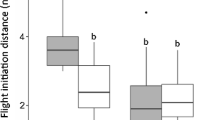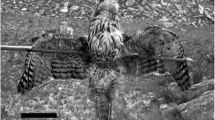Abstract
The escape behavior of the green lizard (Lacerta viridis) was investigated in natural conditions of the Slovak Karst, Slovakia. The seasonal changes of approach distances and types of escape behavior were monitored for both sexes, also in relation to differences in anthropogenic influence. In our study, the escape behavior of green lizard changed significantly during the season, and differ significantly between localities and in respect to human disturbance. At the beginning of the season, females stayed in close proximity to a refuge and hid immediately after being disturbed. Among males, the distance to and from a refuge was longer and any accessible protrusions were used to hide. The approach distance was greater among males. During the mating period, approach distance for females and males was similar and both sexes hid in a refuge. However, after the mating period, the approach distance for females was decreasing, whereas that of males begun to increase.


Similar content being viewed by others
References
Amo L, López P, Martín J (2006) Nature-based tourism as a form of predation risk affects body condition and health state of Podarcis muralis lizards. Biol Conserv 131:402–409
Antczak M, Hromada M, Tryjanowski P (2005) Spatio-temporal changes in great grey shrike Lanius excubitor impaling behaviour: from food caching to communication signs. Ardea 93:101–107
Brana F (1993) Shifts in body-temperature and escape behavior of female Podarcis muralis during pregnancy. Oikos 66:216–222
Broom M, Ruxton GD (2005) You can run—or you can hide: optimal strategies for cryptic prey against pursuit predators. Behav Ecol 16:534–540
Bulova JS (1994) Ecological correlates of population and individual variation in antipredator behavior of two species of desert lizards. Copeia 4:980–992
Cooper WE (1997) Escape by a refuging prey, the broad-headed skink (Eumeces laticeps). Can J Zool 75:943–947
Cooper WE (2000) Effect of temperature on escape behaviour by an ectothermic vertebrate, the keeled earless lizard (Holbrookia propinqua). Behaviour 137:1299–1315
Cooper WE (2003a) Effect of risk on aspects of escape behavior by a lizard, Holbrookia propinqua, in relation to optimal escape theory. Ethology 109:617–626
Cooper WE (2003b) Risk factors affecting escape behavior by the desert iguana, Dipsosaurus dorsalis: speed and directness of predator approach, degree of cover, direction of turning by a predator, and temperature. Can J Zool 81:979–984
Cooper WE, Frederick WG (2007) Optimal flight initiation distance. J Theor Biol 244:59–67
Cooper WE, Peréz-Mellado V (2004) Tradeoffs between escape behavior and foraging opportunity by the Balearic lizard (Podarcis lilfordi). Herpetologica 60:321–324
Crowley PH, Travers SE, Linton MC et al (1991) Mate density, predation risk, and the seasonal sequence of mate choices: a dynamic game. Am Nat 137:567–596
Diego-Rasilla FJ (2003a) Human influence on the tameness of wall lizard, Podarcis muralis. Ital J Zool 70:225–228
Diego-Rasilla FJ (2003b) Influence of predation pressure on the escape behaviour of Podarcis muralis lizards. Behav Process 63:1–7
Dill LM, Houtman R (1989) The influence of distance to refuge on flight initiation distance in the gray squirrel (Sciurus caroliensis). Can J Zool 67:1203–1209
Ekner A, Majlath I, Majlathova V, Hromada M, Bona M, Antczak M, Bogaczyk M, Tryjanowski P (2008) Densities and morphology of two co-existing lizard species (Lacerta agilis and Zootoca vivipara) in extensively used farmland in Poland. Folia Biol 56:165–171
Formanowicz DR Jr, Brodie ED Jr, Bradley PJ (1990) Behavioural compensation for tail loss in the ground skink, Scincella lateralis. Anim Behav 40:782–784
Huey RB (1982) Temperature, physiology and the ecology of reptiles. Biology of the Reptilia 12:25–91
Labra A, Leonard R (1999) Intraspecific variation in antipredator responses of three species of lizards (Liolaemus): possible effects of human presence. J Herpet 33:441–448
Marler CA, Moore MC (1988) Evolutionary costs of aggression revealed by testosterone manipulations in free-living male lizards (Sceloporus jarrovi). Physiol Zool 62:1334–1350
Martín J, López P (1999) An experimental test of the costs of antipredatory refuge use in the wall lizard, Podarcis muralis. Oikos 84:499–505
Martín J, López P (2000a) Fleeing to unsafe refuges: effects of conspicuousness and refuge safety on the escape decisions of the lizard Psammodromus algirus. Can J Zool 78:265–270
Martín J, López P (2000b) Costs of refuge use affect escape decisions of Iberian-rock Lizards, Lacerta monticola. Ethology 106:483–492
Martín J, López P, Cooper WE (2003) When to come out from a refuge: balancing predation risk and foraging opportunities in an alpine lizard. Ethology 109:77–87
Rand AS (1964) Inverse relationship between temperature and shyness in the lizard Anolis lineatopus. Ecology 45:863–864
Schwarzkopf L, Shine R (1991) Thermal biology of reproduction in viviparous skinks, Eulamprus tympanum: why do gravid females bask more? Oecologia 88:562–569
Sih A (1992) Prey uncertainty and the balance of anti-predator and feeding needs. Am Nat 139:1052–1069
Sih A, Krupa JJ, Travers S (1990) An experimental study on the effects of predation risk and feeding regime on the mating behaviour of the water strider, Gerris remigis. Am Nat 135:84–290
Snell HL, Jennings DR, Snell MH, Harcourt S (1988) Intrapopulation variation in predator-avoidance performance of Galapagos lava lizards: the interaction of sexual and natural selection. Evol Ecol 2:353–369
Whiting JM, Lailvaux PS, Reaney TL, Wymann P (2003) To run or hide? Age-dependent escape behaviour in the common flat lizard (Platysaurus intermedius wilhelmi). J Zool 260:123–128
Ydenberg RC, Dill LM (1986) The economics of fleeing from predators. Adv Stud Behav 16:229–249
Zar JH (1999) Biostatistical analysis, 4th edn. Prentice-Hall, Upper Saddle River
Acknowledgements
This work was supported by the Scientific Grant Agency of the Ministry of Education of Slovak Republic and the Slovak Academy of Sciences No. 1-1284-04 (I. Majláth). We thank Jakub Z. Kosicki for his help with the statistical analysis and Martin Hromada for the critical reading of the manuscript and helpful comments.
Author information
Authors and Affiliations
Corresponding author
Rights and permissions
About this article
Cite this article
Majláth, I., Majláthová, V. Escape behavior of the green lizard (Lacerta viridis) in the Slovak Karst. acta ethol 12, 99–103 (2009). https://doi.org/10.1007/s10211-009-0063-8
Received:
Revised:
Accepted:
Published:
Issue Date:
DOI: https://doi.org/10.1007/s10211-009-0063-8




